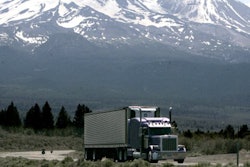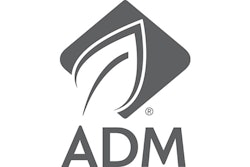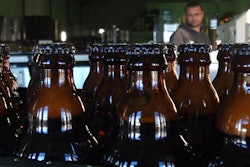When you think about products produced in Ireland, whiskey, Guinness and wool might come to mind. But when it comes to a company’s material handling needs, Combilift — a global manufacturer of multidirectional forklifts and a well-known provider of long load handling solutions — is making waves in the marketplace.
In late April, IMPO joined other North American media members to learn more about Combilift and the secret to their success at the grand opening of the company’s new $58 million (€50 million) facility and global headquarters in Monaghan, Ireland.
Managing director Martin McVicar says the new 500,000-square-foot manufacturing plant will help Combilift bring its ambitious growth plans into reality. With 11 acres of roof space, it is one of the largest manufacturing operations under one single roof in the Republic of Ireland.
“We have employed an additional 230 people since we announced our plans for this factory in 2015 and the combination of this state-of-the-art production plant and the growing skilled workforce will allow us to double production within the next five years,” McVicar says.
The manufacturing facility and global headquarters houses 60 welding bays, two plasma cutting machines, three paint lines — which use sustainable waterbased paints — and three automatic shot blasters.
Combilift North American Sales President Paul Short estimates about 600 tons of steel is delivered to the facility each week to produce the more than 50 truckloads of finished products that leave the factory every week. A finished truck rolls off the line every 15 minutes.
“We’re really ramping up, we’ve got a lot of orders,” Short says.
A New Light
The first thing you notice stepping out onto the assembly floor at Combilift’s new facility is the amount of natural light that fills the space. Even with Ireland’s trademark rainy weather, daylight shines through the skylights casting light that gives the illusion of standing outdoors.
Short explains building plans originally included only one skylight per bay, however when company co-founders Robert Moffett and Martin McVicar toured the building in-progress, they decided to change to two per bay.
“The roof is now 23 percent skylight, that’s why so much sunlight comes in,” Short says. “It really was a smart decision because it is so bright here and the employees are working in natural light all the time rather than artificial. It’s brilliant.”
What unnatural lighting is used in the facility is all LED equipped with sensors that measure the lumens that adjust the lighting appropriately.
“It’s really efficient how it does it,” Short says. “The lights only brighten up to match the darkness so in the evening it just keeps the lighting even, so you don’t even notice it getting dark outside.”
Efficiency is key at the new facility. Solar panels supply 185 kW of energy with a 1 MW Biomass plant fueled by recycled wood, such as pallets, to heat the spraying booths and assembly area. In addition, a 110,000-liter capacity rain water collection system is used in jet washing and the bathroom facilities at the plant.
Making Their Mark
From its inception 20 years ago, Combilift never sought to compete against other, larger, forklift manufacturers.
“We knew we could never make a business in Ireland that would compete with the big brand names,” McVicar says. “Our intention is not to get into the high production of forklift trucks. Our business is very much geared on development of innovative forklift trucks that are focused on a niche market. And we want to become the No. 1 player in whatever market segment we enter.”
The name “Combilift” comes from “combination” which harkens to the company’s unique designs that mesh the advantages of a counterbalanced forklift, side loader and very narrow aisle trucks into one vehicle.
The first market segment Combilift entered was long-load material handling, producing machines that could carry lengthy steel and timber in a more efficient and safe manner. However, when the downturn of 2008 arrived, the construction market slowed and so did the need for Combilift machines.
“We said to ourselves, ‘We need to focus on other industries that are less reliant on the construction sector’,” McVicar says. “So we focused on the warehouses and manufacturing companies around palletized goods.”
With that, the Aisle Master was born. The Combilift Aisle Master articulated forklift lifts up to 15 meters high and can work in aisles as narrow as 1.6 meters. This, McVicar says, can help warehouses and distribution centers increase storage capacity by up to 50 percent.
“Land and buildings are becoming more expensive,” McVicar says. “We believe with the range of products that Combilift provides today, our products can make a difference.”
Since then, Combilift has expanded its product portfolio to include a widerange of material handling equipment, from heavy-load handling products to pedestrian forklifts. Combilift also offers a logistic and warehouse design service, which allows customers to see the benefit a Combilift product will bring to their business.
“Our engineers proactively design, plan and produce solutions in collaboration with our customers by offering material flow analysis and 3D animations,” McVicar says. “We work with customers to produce warehouse designs to visualize the capacity potential as well as the optimum flow of materials on their site.”
Customized For Customers
The other thing that stands out on the Combilift factory floor is the lack of automation. Production at Combilift is still a very manual process. According to McVicar, that’s an advantage.
“That gives us great flexibility so we can tailor make any product a customer needs,” McVicar says. “Combilift has set the benchmark for the mass production of customized innovative products. Mass customization is the new frontier for both the customer and the manufacturer as customers are increasingly expecting products to be tailored to their requirements. We listen to and take feedback on board from our customers and dealers to identify solutions that best match their individual specific needs.”
Because 98 percent of Combilift products are exported internationally, each vehicle is designed to meet all industry standards. Each product starts out in the engineering department, where it is specially designed to meet the client’s unique needs. Before manufacturing begins, all the designs are tested digitally.
“We run several tests,” explains head of engineering Martin Treanor. “We check the capacity of the truck, etc… it's better to find out that you need more counterbalance at that stage than to find out after the truck had already been built.”
After the design stage, the engineer takes on a project management role overseeing the production process from welding to assembly to final testing.
“The engineer will follow that project right up until it’s out the gates to the customer,” Treanor says. McVicar explains that Combilift is motivated by innovation, and this is proven by the more than a dozen patents displayed on the wall of the engineering department — with more in the works. The new facility has a dedicated research and development center, which unfortunately wasn’t part of the media tour, though McVicar says seven percent of revenue goes directly into R&D.
“The flexibility in our new facility means that we can continue to accommodate any request for a
customized material handling solution,” McVicar says. “We also see ourselves as much more than a forklift manufacturer and are transforming the transport and logistics sector with our innovative, space-spacing products and our services.”
Working Local
Combilift currently employs 550 people for the manufacture of its forklifts and material handling products including skilled technicians, design engineers and logistics specialists. Over the next three years the company plans to add 200 new jobs at the Monaghan facility.
With an unemployment rate of six percent in Ireland, it can be an industry challenge to find workers. However, the company is focused on hiring local. Through partnerships with area educational institutions Combilift offers apprenticeship-style traineeship programs. Last year 20 people went through the program and, in the end, all 20 were hired.
“At the moment our revenue is $280 million,” McVicar says. “If we can keep our labor content within 10 percent of that, we believe we can be competitive and export anywhere around the world. If we move this plant somewhere else, all we're going to be saving on is that 10 percent, and with the expertise here, that's not even something to consider.”























